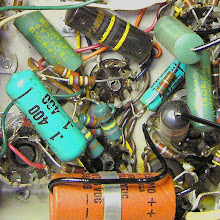This post is from the series of mods I've done to this Champion 600. I'm finally getting down to changing the circuit a bit. My main goal is to clean the amp up a bit, especially in the low end. It's probably going to require a speaker replacement eventually, but I'm starting with the cathode bypass caps.
With most 12AX7 circuits, smaller bypass cap values will reduce the low end response by a bit less than 6dB. The frequency at which the response is down by 3dB is, logically, the "3dB down point" or the "knee frequency". Changing cathode bypass caps can be a bit more subtle than changing coupling caps since the low end response is never reduced more than 6dB - only the knee frequency is changed.
There are two cathode bypass caps in the preamp section of the Champion 600. Either or both of them can be changed out to shape the frequency response of the amp.
Here they're indicated on the pc board layout - C3 is for the first stage and C10 is for the second:

A standard tuned 6 string guitar isn't going to produce anything below 80Hz and even the low frequencies it does produce aren't going to reproduce well though the Champion 600's speaker. Below is a chart with values calculated for the 3dB down point with a series of common cap values. Note the stock value of 22uF has a -3dB point of 9Hz. I'm going to start with a 1.5uF in the first stage and a .68uF in the second and work from there.
If electrolytic caps are used (and they probably will be for the larger values unless you've got deep pockets) it's very important to maintain the polarity of the cap or it will explode under use.

This amp came to me with a printed copy of the Frondelli Mod . The mod itself is fine, but a number of the changes detailed there do the opposite of what this amp owner is looking for. He's looking for a cleaner sound with more low end headroom. Even though Frondelli is limiting the low end somewhat, he is also increasing gain for a more saturated sound. If that's what you're interested in, though, you can tweak the bypass cap value to your taste there as well. The blue resistors in the diagram below indicate the ones changed for the 1st stage in the Frondelli mod (R8 and R2). The bypass cap associated with that stage (C3) is indicated in orange.

Jon Frondelli recommends a .68 uF cap here, but you're free to change it to taste. Below is a chart showing calculated -3dB values adjusted for the new plate and cathode resistor values in the Frondelli mod.

If you're interested in how these values are calculated, drop me an email - or visit Randall Aiken's site.




2 comments:
Thanks a million for these charts. They really helped me zero in on an alternative value to the .68 bypass cap in my Frondelli-modded Champ 600. I settled on a 10uF. I installed this on an ON-OFF-ON switch so I can get the .68 uF, 10 uF, or no bypass cap at all, which is pretty good for clean sounds. The 10 uF cap gets flabby with super-heavy overdrive, but sounds fantastic from clean to semi-dirty. This goes double when running into an external 12" speaker.
This is a great site Andy. I've learned a lot here.
Jason
Post a Comment